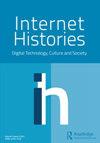Genealogies of online content identification - an introduction
IF 1.2
Q3 COMMUNICATION
引用次数: 1
Abstract
In today’s digital landscape, cultural content such as texts, films, images, and recorded sounds are increasingly subjected to automatic (or semi-automatic) processes of identification and classification. On a daily basis, spam filters scan swaths of emails in order to separate legit and illegitimate textual messages (Brunton, 2013), algorithms analyze years of user-uploaded film on YouTube in search for copyright violations (Heuguet, 2019), and software systems are deployed to scrutinize millions of images on social media sites in order to detect sexually offensive content (Liao, 2018). These examples reveal how machines and algorithmic systems are increasingly utilized to make complex judgments regarding cultural content. Indeed, it could be argued that the wideranging adoption of content identification systems is constructing new ontologies of culture and regimes of truth in the online domain. When put to action, content identification systems are trusted with the ability to separate good/bad and legal/illegal forms of communication and used to secure the singularity, value, authenticity, origin, and ownership of content. Such efforts are deeply embedded in constructions of knowledge, new forms of political governance, and not least global market transactions. Content identification tools now make up an essential part of the online data economy by protecting the interests of rights holders and forwarding the mathematization, objectification, and commodification of cultural productions. Parallel to their increased pervasiveness and influence, however, content identification systems have also been increasingly contested. Debates regarding automatic content identification tools recently gained momentum due to the European Union’s decision to update its copyright laws. A newly adopted EU directive encourages all platform owners to implement automatic content filters to safeguard copyrights (Spangler, 2019) and critics have argued that such measures run the risk of seriously hampering the freedom of speech and stifling cultural expressions online (e.g., Kaye, 2018). A wide range of high profile tech figures (such as Tim Berners Lee, commonly known as one of the founders of the World Wide Web) have even warned that the widespread adoption of pre-emptive content identification systems could effectively destroy the internet as we know it (Cerf et al., 2018). Content identification systems, then, are not neutral devices but key sites where the moral, juridical, economical, and在线内容识别的家谱-简介
在当今的数字环境中,文本、电影、图像和录音等文化内容越来越多地受到自动(或半自动)识别和分类过程的影响。垃圾邮件过滤器每天都会扫描大量电子邮件,以区分合法和非法的文本信息(Brunton,2013),算法分析用户在YouTube上上传的多年电影,以寻找侵犯版权的行为(Heuguet,2019),并部署软件系统来审查社交媒体网站上的数百万张图像,以检测性攻击内容(Liao,2018)。这些例子揭示了机器和算法系统如何越来越多地被用来对文化内容做出复杂的判断。事实上,可以说,内容识别系统的广泛采用正在构建网络领域新的文化本体和真相制度。当内容识别系统投入使用时,人们相信它能够区分好/坏和合法/非法的通信形式,并用于确保内容的独特性、价值、真实性、来源和所有权。这些努力深深植根于知识建设、新形式的政治治理,尤其是全球市场交易。内容识别工具现在通过保护权利持有人的利益和促进文化产品的数学化、物化和商品化,构成了在线数据经济的重要组成部分。然而,在其日益普及和影响力的同时,内容识别系统也受到了越来越多的质疑。由于欧盟决定更新其版权法,关于自动内容识别工具的争论最近愈演愈烈。一项新通过的欧盟指令鼓励所有平台所有者实施自动内容过滤器以保护版权(Spangler,2019),批评者认为,这些措施有严重阻碍言论自由和扼杀在线文化表达的风险(例如,Kaye,2018)。许多知名科技人士(如Tim Berners-Lee,通常被称为万维网的创始人之一)甚至警告说,先发制人的内容识别系统的广泛采用可能会有效地摧毁我们所知的互联网(Cerf等人,2018)。因此,内容识别系统不是中立的设备,而是道德、司法、经济和
本文章由计算机程序翻译,如有差异,请以英文原文为准。
求助全文
约1分钟内获得全文
求助全文

 求助内容:
求助内容: 应助结果提醒方式:
应助结果提醒方式:


